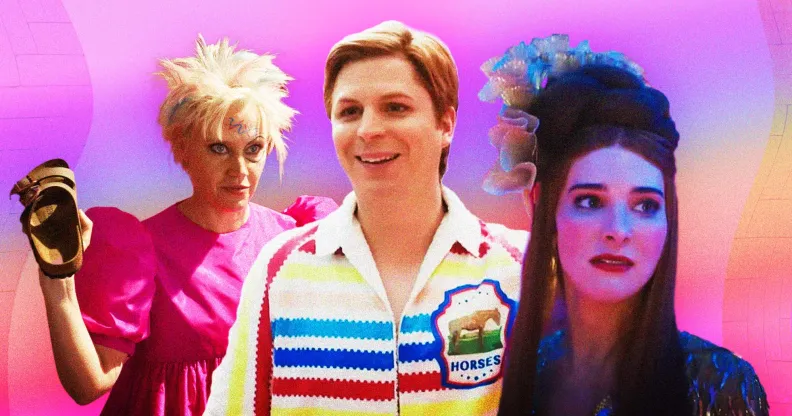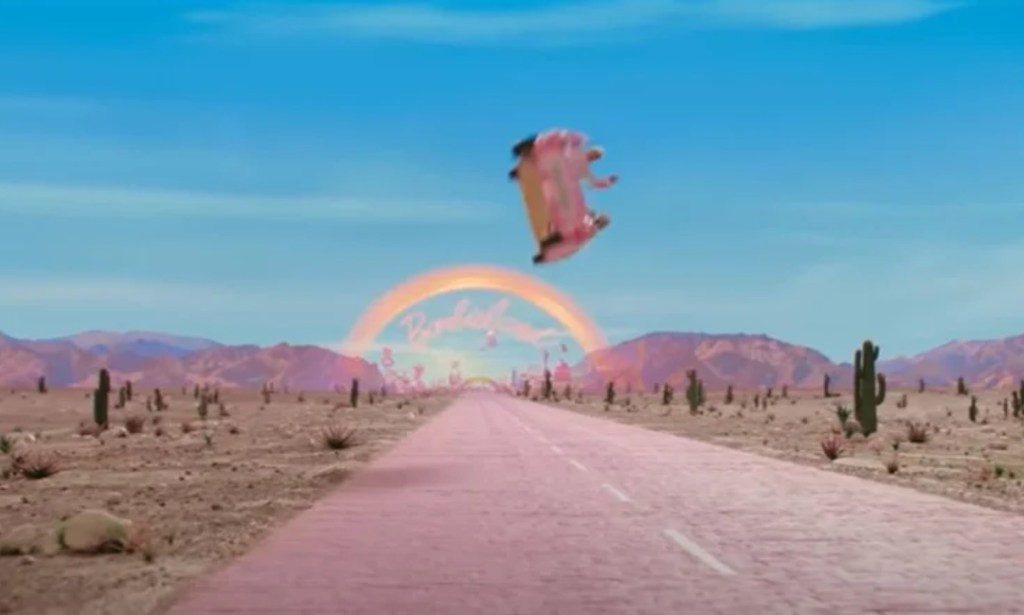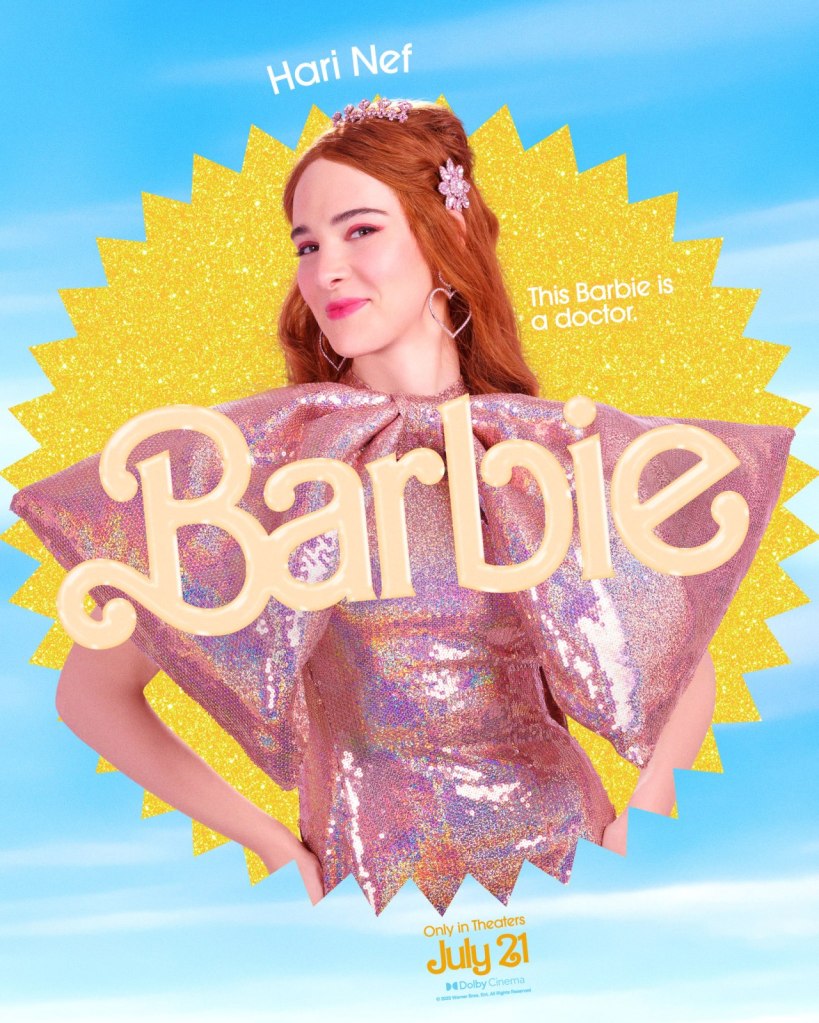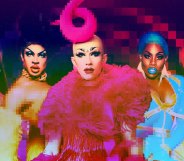All the genius LGBTQ+ Easter eggs in Barbie, from Birkenstocks to The Wizard of Oz

Allan, Birkenstocks and The Wizard of Oz: All the LGBTQ+ Easter eggs in Barbie you might have missed (Warner Bros)
With Greta Gerwig’s Barbie delivering a record-breaking box-office opening weekend, we uncover all the genius LGBTQ+ references in the film.
Since its creation in 1959, Mattel’s iconic Barbie doll has influenced generations of young girls, for better or for worse. Despite its inspirational “you can be anything” slogan, the original Barbie was perceived as an arbiter of harmful stereotypes and female beauty standards in the second half of the 20th century (think thin, white and geometrically impossible proportions).
Sixty-four years later, however, the Barbie range boasts more than 170 dolls with various body types (petite, tall and curvy) and several different skin tones. It has also developed a sizeable extended universe, including a range of accessories, animated films and a YouTube vlog channel with 11.4 million subscribers.
From everyone’s favourite camp add-on, the Ken doll (aka Barbie’s himbo boyfriend) to the straight-to-video animations that shaped a generation of girls, gays and theys, the toy brand simply doesn’t miss.
The aggressively pink branding, mercurial message of female empowerment and endless re-invention has culminated in one of the most highly anticipated live-action blockbusters in recent cinematic history.
Directed by Oscar-nominated Gerwig, Barbie stars Margot Robbie (I, Tonya) as “stereotypical” Barbie opposite Ryan Gosling’s airhead Ken alongside a supporting cast of A-listers such as Will Ferrell, America Ferrera, Ncuti Gatwa, Hari Nef, Dua Lipa, Issa Rae, Michael Cera and Helen Mirren.
When Barbie is plagued by thoughts of existential dread and discovers that life in plastic isn’t as fantastic as she once believed, she ventures into the “Real World” to find answers – and confronts Mattel’s six-decade-old baggage, with plenty of self-aware jokes along the way.
Of course, nothing goes better with the crushing realisation of your mortality than a healthy dose of campy queer vibes: from the pop-heavy soundtrack, featuring an Aqua “Barbie Girl” remix by Nicki Minaj and Ice Spice as well as tunes from Sam Smith and Charli XCX, to the Drag Race runway-ready costumes, this film was made with the LGBTQ+ community in mind.
Although Robbie has clarified there are no explicitly LGBTQ+ characters, Barbie is clearly doing something right if bigots are accusing it of pushing the queer agenda. Here are the LGBTQ+ Easter eggs, references or moments that are simply too queer to ignore.
Margot Robbie’s ‘stereotypical’ Barbie has lesbian subtext
No doubt countless sapphics will be familiar with the “making your Barbie dolls scissor and obsessing over the 2006 animated Barbie in the 12 Dancing Princesses to coming out as a lesbian” pipeline. Now, Barbie is honouring this queer legacy.
The film sees out gay SNL comedian Kate McKinnon play the wise but ostracised “weird” Barbie, complete with haphazardly cut hair, a face covered in marker pen and legs stuck in the permanent split position.
When Robbie’s “stereotypical” Barbie seeks her sage advice on why her picture-perfect life is falling apart, McKinnon’s Barbie offers her a Matrix-style (red pill/blue pill) choice: return to her rhinestone-clad, high-heeled existence, or “know the truth about the universe” with a pair of Birkenstocks, aka the most lesbian shoe to ever exist.
Articles dating back to the early 1990s refer to the clear link between Birkenstocks (rugged practical sandals) and lesbianism. Some have posited that the strange association occurred when lesbians purposefully bucked traditional beauty standards to challenge the patriarchy.
After some hesitation, stereotypical Barbie chooses the Birkenstock path, but the queer coincidences don’t end there: the entire scene is set to “Closer to Fine”, a hit song from lesbian folk rock duo Indigo Girls.
Now a lesbian anthem, the lyrics explore themes around understanding yourself and your place in the world.
As stereotypical Barbie embarks on her journey of self-discovery, several more sapphic moments take place. Fans have pointed out her undeniable chemistry with Gloria (played by America Ferrera), the human who owns her doll equivalent, when the pair share an intense (and loaded) gaze after meeting for the first time.
On top of that, stereotypical Barbie is not even remotely interested in pursuing a relationship with Ken and ends the film with her wearing – you guessed it – a pair of Birkenstocks.
Gay classic The Wizard of Oz partly inspired Gerwig’s Barbie
Gerwig has a lengthy list of films that inspired Barbie‘s creative direction, from old-school Hollywood hits such as Singin’ in the Rain and The Godfather to the disco vibes of Saturday Night Fever and the meta moments of The Truman Show.
In fact, Gerwig hosted weekly film-watching sessions (known as movie church) for the cast and crew, to help them understand her vision, and many will be thrilled to hear that the quintessential queer musical The Wizard of Oz proved to be a key inspiration.
Since gay icon Judy Garland sang the first notes of “Somewhere Over The Rainbow”, the story’s technicolour themes of accepting yourself, chosen family and feeling at home in a pair of sparkling ruby-red slippers have undeniably resonated with the LGBTQ+ community.
In an interview with Letterboxd, Gerwig explained why she wanted to “emulate” this the Oscar-winning classic.
“The Wizard of Oz, obviously, is an extraordinary movie.” she said. “It does something that I wanted to emulate, which is these incredible sound stages and these painted skies and this sense of… I say, ‘authentically artificial’, which I think is very beautiful and emotional.

“I think of the painted backdrop of the Emerald City as they go towards it. In our movie, we have the pink brick road instead of the yellow brick road. We also have beautiful painted backdrops of horizons.
“We executed it like they would’ve done in the ’30s, ’40s and ’50s sound-stage musicals. It was something that we kept returning to. I always love the ending where there’s a ceremonial quality.”
Ryan Gosling’s Ken doll is highly gay-coded
We can’t talk about Barbie without discussing her “long-term, long-distance, low-commitment, casual” boyfriend Ken. As well as the Ken doll’s inherently fruity nature, there’s plenty of evidence to back-up Ken’s queer vibes.
Gerwig told Rolling Stone that “some combination of Marlon Brando meets Gene Wilder meets John Barrymore meets John Travolta” influenced her exaggerated characterisation of Ryan Gosling’s Ken. Over the years, Brando (A Streetcar Named Desire), Wilder (Willy Wonka & the Chocolate Factory) and Travolta (Grease) have all been key figures for the LGBTQ+ community.
The film itself includes a running gag between Gosling and Simu Liu’s Ken in which they aggressively threaten to “beach other off”. Meanwhile, another scene features a brief cameo from “Earring Magic” Ken, a doll introduced in 1993 that was affectionately dubbed “cock ring Ken” or “gay Ken”. You get the picture.
Although “Earring Magic” Ken was discontinued after consumers pointed out its heavy queer association, it has long held a special place in gay hearts.
Michael Cera’s Allan doll has a long gay history
All that leads us nicely to Barbie‘s big gay elephant in the room: Ken’s homoerotic buddy Allan (played by Michael Cera). First introduced in 1964, Allan (reinvented as Alan in 1991) was eventually discontinued in 2012, but not before it was adopted by the queer community.
Allan was marketed as Ken’s only friend and even came with the tagline that all Ken’s clothes fit him. The queer backstory practically writes itself.
Cera’s Allan is an awkward, shy, multi-coloured doll, terrified of the patriarchy, who happily teams up with the Barbie dolls to take down the toxic masculinity that has infiltrated Barbie Land.
There are several moments that have left audiences doing a double-take over Allan’s sexuality, from the odd reaction he had when the Kens were demanding foot massages, or the time he started tearing up when he saw Ken’s Gosling in distress at the end of the film.
At the end of the day, he’s just one of the gals.
Hari Nef’s Doctor Barbie in all her queer glory
Hari Nef brought trans representation to the cast in her role as Doctor Barbie.
In an interview with Out magazine, Nef confirmed that although her character is not technically trans, she hopes she can empower trans girls everywhere to dream big.
Nef weaves queerness into other aspects of the character. In an interview with Vogue, she explained the hilarious back story she gave the owner of her doll in the real world.
“[He is] a gay man in his fifties, who lives in a rent-controlled apartment in the West Village,” she said, pointing to her outfit, which is made up of a pink sequinned dress, a large bow, matching heart earrings, flower hair pin and tiara.

What’s more, Nef explained the entire costuming for the film looked like something out of Drag Race, with its use of extravagant designs and vibrant colour.
“I’ve joked before, it really did feel like Greta Gerwig’s Drag Race,” she said. “I was doing acting, dancing, comedy, and the whole time I was wigged, painted from head to toe, padded, heels.”
Barbie is in cinemas now.

